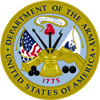Located just outside of Richmond, VA, Fort Lee is the Army’s home of all things logistics. It is the third largest training site in the Army, in terms of sheer numbers trained each year.
Quick Facts
| Coordinates | 37° 15' 21.22" N 77° 20' 00.86" W |
|---|---|
| City | Prince George, VA 23801 |
| Phone | 804-734-6388 |
| DSN | 687-6388 |
History of Fort Lee
World War I
Shortly after the United States declared war on Germany in 1917, the War Department acquired a vast amount of farmland in Prince George County, Virginia for the purpose of building 1 of 32 military cantonments. More than 1,500 buildings and 15 miles of on-post roads were built and Camp Lee became one of the largest cities in Virginia. More than 60,000 Soldiers trained there prior to their departure for the Western Front, fighting in France and Germany. Camp Lee continued to serve as an out-processing center during 1919 and 1920. However, in 1921 the camp was formally closed and many of the structures torn down. There are few visible signs of the training and activities that took place during World War One. Following the closure, the property was managed by the Commonwealth of Virginia and used as a game preserve.
World War II
As tensions rose worldwide in the late 1930s, Congress approved the call-up of nearly 300,000 Guardsmen and Reservists in late 1940. They also passed a Selective Service Act that allowed the drafting of up to 900,000 more men for a year. In October of 1940, the War Department issued an order to rebuild Camp Lee on the same site as before. In October of 1941 (two months prior to Pearl Harbor) the Quartermaster School moved from Philadelphia to Camp Lee in order to begin training Soldiers on the art of military supply. Camp Lee became the third largest city in the state of Virginia during the course of the war. It trained over 300,000 Quartermaster Soldiers. Following World War II, Camp Lee continued to serve as the primary Quartermaster fielding installation.
Korean War
In 1950 the War Department reached a decision to keep Camp Lee as a permanent facility and hence renamed Camp Lee to Fort Lee. Fort Lee then began training airborne riggers. Around this time the Korean War broke out and Fort Lee once again sprang to life. Tens of thousands of Soldiers arrived to receive logistics training in preparation for their support in Korea. The 1950s and 1960s were a time of modernization for Fort Lee. Many of the wooden structures were replaced with brick and cinderblock structures. Multi-story brick barracks were constructed, a new three-story Quartermaster school classroom was constructed, and Kenner Army Hospital opened in 1962.
In 1973, the Continental Army Command (CONARC) headquarters at Fort Monroe was replaced by the U.S. Army Training and Doctrine Command (TRADOC). TRADOC then established the U.S. Army Logistics Center at Fort Lee. TRADOC focused on serving the Quartermaster, Transportation, Ordinance, and Missile and Munitions branches of the Army.
Modern Era
Fort Lee received a major boost when Congress passed the Base Realignment and Closure legislation in 2005. The installation was given an important new mission: establish a Sustainment Center of Excellence that would serve as a focused training base for military supply, services, maintenance, munitions, and transportation. Upon this news, Fort Lee experienced a great infrastructure boom. The new Sustainment Center of Excellence was constructed for $50 million.
Today Ft. Lee is the center of logistics for the United States Army. It continues to train officers and noncommissioned officers in the field of logistics.
For more on the history of Ft Lee and the Army itself, visit the U.S. Army Quartermaster Museum or the U.S. Army Women’s Museum. Both are located in Fort Lee, VA.
Quick Facts
- As many as 70,000 troops will pass through Fort Lee’s classrooms each year
- Over 9,000 students are trained at Fort Lee each day
- Average rainfall: 43.9 inches
- Average high temperature in July: 90ºF
- Average low temperature in January: 27ºF
- Median household income: $58,769
Click here to learn more about Fort Lee Demographics.
Arriving at Fort Lee
The Soldiers Support Center is located in building 3400, between B and C Avenues and 16th and 17th Street. It is the first stop that all permanent party Army personnel should make when reporting to Fort Lee. The Soldier Support Center is open for general operations from 8 a.m. – 4 p.m. After hours, permanent party should report to the Installation Operations Center, BLDG 1107, in order to sign in off of leave and receive required instructions for the next duty day.
Extracurricular Activities
Richmond, VA is home to over 200,000 people and is only a 45 minute from Fort Lee. It is located at the fall line of the James River and 98 miles south of Washington D.C. Richmond is a popular choice for many Soldiers on the weekends. From farmers markets, tubing and fishing in the James River, the Richmond Raceway, numerous nature walks, and many bike trails, there is always something to do in Richmond. It is deemed a “foodie city” by many, as it is a lively restaurant scene.
Washington D.C. is a two hour and fifteen minute drive from post. It is a popular weekend destination for many Fort Lee residents.
If the beach is your scene, Virginia Beach is less than two hours away. The Outer Banks in North Carolina are less than four hours away.
Helpful Resources
Fort Lee Commissary: 804-765-2254
